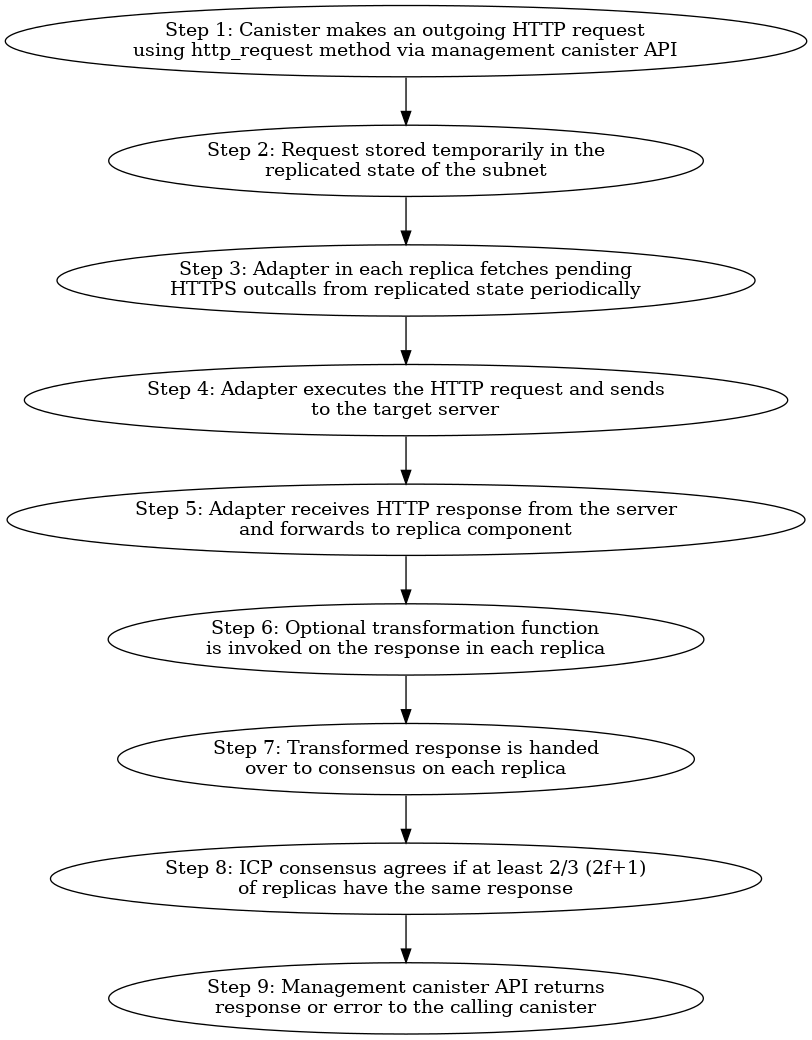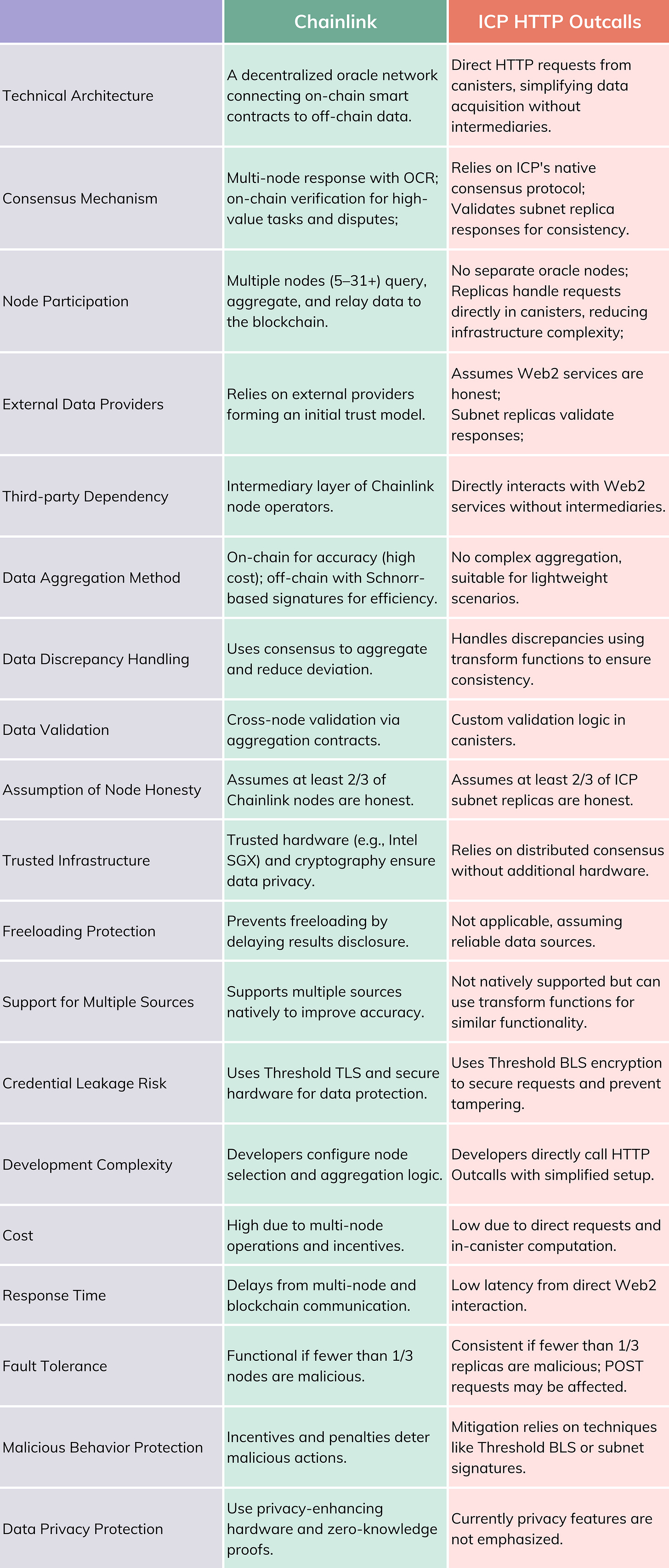ICP's HTTP Outcalls vs Chainlink’s Oracle Solution In-Depth Analysis
Discover how Internet Computer's direct Web2 integration simplifies data retrieval for cost-sensitive, low-latency applications.
Takeaways
ICP enables smart contracts (canisters) to directly interact with Web2 services via HTTP outcalls, offering low-cost and low-latency solutions by simplifying external data retrieval without the need for third-party oracles.
Oracle like Chainlink ensures high data reliability and security through a decentralized oracle network with multi-node aggregation and consensus, suitable for complex, high-value use cases but at higher costs.
ICP prioritizes simplicity and efficiency, making it ideal for lightweight, low-latency scenarios, while Chainlink emphasizes decentralization and robustness for data-intensive applications requiring trust minimization.
The integration of blockchain technology with real-world data is essential for decentralized applications (dApps). One major challenge is enabling interactions between on-chain smart contracts and off-chain data sources.
The Internet Computer (ICP), developed by the DFINITY Foundation, addresses this challenge with a feature called HTTP outcalls. Traditional blockchain ecosystems often rely on third-party oracle solutions, such as Chainlink, to bridge the on-chain/off-chain gap.
This document explores how ICP’s HTTP outcalls and Chainlink's oracle solutions work, comparing their mechanisms, efficiency, costs, and ease of integration.
1. HTTP Outcalls on ICP
HTTP outcalls enable IC smart contracts, or "canisters," to directly send HTTP requests to external Web2 services and receive responses. This built-in capability removes the need for external oracles to connect on-chain and off-chain data sources.
Key elements of ICP HTTP outcalls include:
Direct Interaction: Canisters can seamlessly access real-time external data.
Infrastructure: Outcalls operate through boundary nodes, which process and route HTTP requests from canisters to external servers and return responses.
How HTTP Outcalls Work
Request Initialization: A canister triggers an HTTP request using the http_request method in the management canister API.
Temporary Storage: The request is stored temporarily in the replicated state of its subnet, ensuring redundancy.
Execution: Each replica in the subnet sends the request via an adapter component, isolated in a sandbox for security.
Consensus Processing: Subnet replicas process responses and validate them through a consensus mechanism. At least two-thirds (2f + 1) of the replicas must agree on the data for the response to be finalized.
Response Delivery: Once validated, the response is sent back to the originating canister.
Boundary nodes play a crucial role in ensuring security and data integrity by managing external interactions and implementing cryptographic verification to maintain a secure flow of information.
Source:https://internetcomputer.org/docs
2. Chainlink Oracle Solutions
Chainlink offers a decentralized oracle network for connecting blockchain smart contracts with external data sources. Its architecture has three main components:
Oracle Node Network: A decentralized set of nodes independently retrieves and relays data to the blockchain. This ensures resilience against single points of failure.
Consensus Protocol: Responses from multiple nodes are validated via an aggregation contract that determines the most reliable data.
Off-Chain Reporting (OCR): Nodes agree on data off-chain to reduce costs and congestion. Once consensus is reached, the result is submitted on-chain.
Chainlink Data Exchange Process
A smart contract requests external data.
Oracle nodes fetch data from APIs or sources as specified.
The nodes conduct off-chain consensus to create an aggregated report.
The report is submitted on-chain and validated by an aggregation contract.
Chainlink’s structure ensures secure and reliable data exchange but introduces higher costs and complexity due to its multi-node operations and aggregation mechanisms.
3. Comparison of ICP HTTP Outcalls and Chainlink
Through a brief synopsis of Oracle, represented by the chainlink, and the previously described ICP HTTP outcall. We will compare ICP HTTP outcalls with Chainlink in a number of ways using the table below:
The table reveals two distinct design philosophies for integrating off-chain data into blockchain systems:
Chainlink: Decentralization and Robustness
Chainlink prioritizes decentralization and trust minimization. Its multi-node architecture and hybrid consensus mechanisms ensure data accuracy, security, and resistance to tampering. This approach is well-suited for high-value applications where data reliability and integrity are critical, but it comes at the cost of higher complexity, operational costs, and latency.
ICP HTTP Outcalls: Simplicity and Efficiency
ICP HTTP Outcalls Function focuses on streamlining data acquisition by directly interacting with Web2 services via canisters. This design reduces infrastructure requirements and is optimized for low-cost, low-latency use cases. However, it relies on the assumption of trustworthiness in Web2 data providers, making it more suitable for lightweight applications.
4. Conclusion
Based on the comparison above, we can see that Chainlink is a decentralized oracle network that primarily aggregates information from multiple data sources through external nodes (oracle nodes). This makes it particularly well-suited for complex applications requiring multi-source data integration, especially in the financial sector, where it can provide reliable, aggregated data from various financial markets to ensure accuracy and consistency.
By combining its off-chain consensus mechanism (OCR) with on-chain verification, Chainlink achieves efficient and secure data aggregation while preventing malicious node behavior and data tampering.
However, due to its reliance on multiple external nodes, Chainlink's trust model is relatively complex, and its data aggregation and storage processes incur higher costs. This may not be ideal for cost-sensitive applications. Chainlink is best suited for complex applications that require robust multi-source data integration and high data reliability, particularly in critical areas like finance. While it offers strong security and trust guarantees, it comes at the expense of higher costs and a more intricate trust model.
In contrast, ICP is better suited for applications that are extremely sensitive to latency and cost, particularly when data interactions do not require multiple external data sources.
With its built-in distributed consensus and HTTP Outcalls functionality, ICP offers a simple and efficient solution by directly interacting with Web2 services without relying on third-party nodes.
Its robust distributed consensus mechanism, leveraging Threshold BLS signature technology, ensures that data retrieved from external services is both secure and verified. This architecture is highly developer-friendly, as it simplifies the data retrieval process and reduces dependence on external services and nodes, making it ideal for low-latency, cost-sensitive applications.
ICP's design allows developers to initiate requests and validate data directly within canisters, minimizing intermediaries and reducing aggregation overhead, which is perfect for lightweight and fast-response scenarios. While ICP may not match Chainlink's capabilities in aggregating diverse data sources, it excels in fast and secure Web2 data interactions, making it particularly suitable for applications with stringent latency requirements.
Reference
https://internetcomputer.org/docs/current/references/https-outcalls-how-it-works
https://blog.csdn.net/wuzhengfei1112/article/details/113784102
Our Latest Research Articles
IC Network Boundary Node Architecture Transformation: Boosting Security, Scalability, and Decentralization
The Internet Computer Protocol (ICP) is preparing to introduce major updates to its boundary node architecture, aiming to bolster the network's security, stability, and scalability. The new architecture will differentiate between two node types—HTTP Gateways and API Boundary Nodes—and focus on disaster recovery and event handling. This article will expl…










